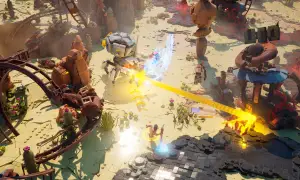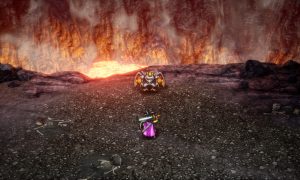Don’t think of Sportsfriends as a compilation of minigames; think of it as an indie anthology. Sportsfriends represents the distinct visions of four independent developers united for one purpose—to bring friends together. It has been called a “party game”, which it is, but it is also a manifesto, a conscious rejection of digital disconnectedness. There are no single-player or online modes to be found here. Sportsfriends has had enough of your Skyrim obsession and your World of Warcraft subscription, and it really just wants you to invite some friends over for some fist-bumping, controller-sharing, and aggressive back-patting. It’s hard to find fault with such an aim, even if the included games themselves may fall a little flat.
While Sportsfriends as a whole is presented in a pleasingly unified manner, each game in this package is as different as the developers who worked on them. Comprised of Noah Sasso’s BaraBariBall, Bennett Foddy’s Super Pole Riders, Douglas Wilson’s Johann Sebastian Joust, and Ramiro Corbetta’s Hokra, Sportsfriends represents an unprecedented cross-section of independent game development, particularly remarkable for its presence on a console system.

Hokra is the most austere of the collection. Graphically simplistic, yet clean and crisp, Hokra feels like an HD remake of an Atari 2600 soccer game. A tiny square ball is placed at the center of the screen, and four players guide their larger squares around to carry and pass the ball towards even larger squares of their color which function as goals wherein points are progressively accumulated. The larger squares fill up with darker colors the longer the ball is within bounds, and once filled, the corresponding team wins. Walls and and other obstacles provide variation on this gameplay, but largely what you see is what you get with Hokra. Like soccer, the passing game is crucial, but unlike soccer, you only have one other teammate.
Four player positions are enforced in Hokra, although a single DualShock can be shared, effectively allowing a two- or three-player match. Controller sharing was almost certainly implemented so that gamers owning less than four controllers could still have a full game, but two player squares can be simultaneously controlled by one player, although at an obvious handicap. It’s very easy to lose track of which numbered, colored square is which in four-player, but differentiating which analog stick goes with which identically colored square in two-player can be hilariously infuriating.
A map editor is included with Hokra, which should help to alleviate the somewhat dull stock offerings, although there is no way to share or download maps, an oversight which seems egregious, even taking into account Sportsfriends focus on local multiplayer. That said, collaborative map building may in fact be Hokra’s greatest achievement and biggest draw—the simple nature of the map editor allows for engaging group conversations about balance and game design, followed by on-the-fly playtesting of whatever broken, nightmarish mess has been cooked up. It’s a shame that Hokra does not lead with the editor, and disappointing that there are not more options to modify play—even the addition of an option for a second ball would have drastic implications for the longevity of the game, and a 6–8 player mode (on 3–4 DualShocks) could be brilliant. As it stands, the current implementation of Hokra is fun, but underwhelming.

BaraBariBall will likely be the most familiar entry to “core” gamers, as well as the most unwelcoming to more casual players. In a two- to four-player battle arena, a ball is placed at the center which must be dropped, thrown, or smacked into the water on the side of the screen opposite each team’s starting area. The ball must sink beneath the surface of the water and off screen to score, meaning that the other team can potentially “recover” the ball by diving into the water and resurfacing with the ball before it reaches the goal. A player sinking completely off-screen results in a loss of points, so they will have to be careful about when they let go of the ball to successfully score, and how far they’ll go to recover it while defending.
Central objectives aside, the gameplay of BaraBariBall consists of smacking the hell out each other, multi-jumping around, falling dejectedly off-screen, dodge-rolling past your enemies, and guarding the edge of a platform with a charged up super-attack to shut down your opponent’s recovery attempt. That’s right, BaraBariBall is Super Smash Bros. Lite, and it doesn’t seem even a little ashamed of its overt and liberal borrowing from the Nintendo franchise. Unlike Smash Bros., however, BaraBariBall has a roster of only three characters: the fast but weak girl, the average boy, and the tough but slow body-builder. Each has two super-moves to choose from, although the super-moves are not particularly effective, especially since damaging opponents is a secondary, not primary goal. There are more stages to choose from than there are characters and are generally well designed, yet almost entirely static and non-interactive.
Because of these limitations and because of the erratic nature of the game camera, BaraBariBall is better enjoyed with two players than with four. In a one-on-one match, players are free to play more methodically and strategically, making the most use of every multi-jump and score attempt. With four players, there will always be at least two using the same character, mix-ups over the ball become hard to follow, and matches descend into general chaos. Most of what makes Smash Bros. such an enduring multiplayer staple remains in BaraBariBall, so even unreasonably chaotic matches are still enjoyable, but fighting games thrive on iconic characters and ridiculous spectacle, both of which are largely absent from BaraBariBall. Although the health bars have been removed and a ball has been added, the pedigree of arena fighters remain, and for better or worse it is through them that BaraBariBall will be perceived.

Super Pole Riders is an arousing foray into man entanglement. It’s also the best of the traditional games on offer in Sportsfriends, and the most satisfying to subvert. Up to four pole riders can play with each other, and controller sharing is encouraged. A ball is placed on a rope in the center of a flat arena, and the teams or individuals control both pole and rider separately to push the ball into the opposing goal. Players can try to simply hold their pole erect and guide the ball to its destination, or they can vault up towards the ball to vigorously shoot it towards the goal and potentially kick another rider or two in the face, forcing them to pull out and start all over.
The best moments of Super Pole Riders, however, are the standoffs. Vigorous pole manipulation can result in riders forcefully stuck to each other, poles entwined as they each attempt to prove their dominance. These situations can become particularly elaborate in a four-way encounter, with three players trapped in passionate struggle while the first sits atop their poles, ball just within reach. Sometimes, it is even more pleasurable to allow these affairs to continue for the duration of the match, as the sudden death tiebreakers of Super Pole Riders are indecently fun. When playing one-on-one, players are stripped of their poles and given giant wobbly mallets with which to deliver great blows upon the ball and their opponent. Add multiple partners, however, and the game instead forces each team of two to share a single pole on which they must work together to finish before the other team scores.
It may come as a surprise, but the wacky physics and goofy sense of humor present in Super Pole Riders make it the most accessible of the bunch. The game is so ridiculous that it doesn’t matter if you’re playing it right, or if there is a lack of configurable options, or a rather small selection of stages. It plays well in either two or four player mode, and the stages that are present have unique differences that make them feel like more than just furniture rearrangement. Super Pole Riders might not be a game that anyone plays for hours at a time, but as a casual romp on the couch for four, it succeeds brilliantly.

Johann Sebastian Joust is the centerpiece of the Sportsfriends anthology, its true reason for being. It is culture-jamming gone digital, a video game in which there is no video and you have to touch other people to win. JS Joust has spent years touring various conventions and events, generating buzz and providing valuable commentary on why and how we game. Now we all have the ability to recreate that experience, although it may not be as straightforward as you think.
The rules of JS Joust are simple: jostle your opponent’s controller by whatever means reasonable while keeping yours steady. If moved too fast, dropped, or shaken, the controller will vibrate and (if using a compatible controller) light up red to signal that the player is out. The speed of the music playing in the background affects how fast the players can move—a slow tempo advises caution while an increased tempo allows for daring assaults. Up to seven can participate (on PS3, PS4 is limited to four), using either PlayStation Move or DualShock controllers. The default accompaniment is Bach, naturally, although the PS3 Joust allows for custom playlists built from the system menu.
Played at home, JS Joust is still the same game we saw at conventions, but being a physical game, the enjoyment of JS Joust varies greatly based on situational constraints. Most obviously, you can’t play a seven-player game if you don’t have seven controllers. DualShocks are supported, but the game was designed for PS Move and it shows. The graspable nature and color-changing lights of the Move allow for much more intuitive and flexible play, and having DualShock 3s in the mix at all will remove the potential for teams, since that version of Sony’s controller doesn’t have a built-in light to signify team affiliations. More critically, however, is the issue of space. JS Joust can be played in an average living room, but it is far less than ideal. Players need space to run around in, to withdraw, and to accommodate larger groups. It is absolutely doable to host a small group or a one-on-one tournament in a small space, but concern over tripping on or damaging something prevail, tactics can become stale with such a narrow field of engagement, and games tend to run extremely short due to the close proximity of the participants.
It is probably best to continue to view JS Joust as an event game—not that it can’t be enjoyed amongst friends at home, but it comes into its fruition when allowed resources not available in the typical house or apartment. Unfortunately, this version of JS Joust has a real lack of customizability or support for competitive play. There are only two music speeds: fast and slow, and the game always starts on slow. When playing a custom playlist, tracks can’t be skipped, and the game will play each song front to back, which can take an annoyingly long time with all the slowdown. A scoreboard can be enabled on the screen, but there’s no way to attach tags or names to the players, and the scores for each controller reset as they hit ten points. Perhaps some of these issues will be rectified for the upcoming PC release, although at this point its sheer speculation whether that release will have any added features or flexibility.

When Johann Sebastian Joust works, it engenders a level of accessibility and physical fun that we don’t often see in the video game marketplace. It is a clear call for more games that allow us to interact with each other and not just with a TV, and that it succeeds as well as it does is worthy of commendation. For the space that is a gaming room, however, it seems unlikely to remove the more traditionally popular video games from their place of importance. As JS Joust is Sportsfriends in its purest form, this applies equally to the more diluted forms of the ideal that exist in Hokra, BaraBariBall, and Super Pole Riders. This is not to say that these games are not important, however.
Sportsfriends is an anthology that exists to show gamers something different. It is four unique perspectives on the question of how we play together, and while these disparate answers may not completely satisfy us, they don’t have to. It is significant enough that Sportsfriends exists and that we can talk about it; it is significant enough that the play of this collection can provoke discussions about level design, physical space, the nature of sports, and wobbly poles. It is significant enough that all of this occurs within the context of a genuinely enjoyable local multiplayer experience. BaraBariBall, Hokra, Super Pole Riders, and Johann Sebastian Joust may not revolutionize game design, but by granting access to an collection such as this to a mainstream console audience, Sportsfriends will definitely inspire it.

What the individual games of this indie anthology lack in scope or depth is made up for by the sheer diversity on display, as well as the high level of commitment to the social and physical aspects of gaming. Sportsfriends represents a high point of a growing trend in independent game development, and functions as a template for future indie collective releases. There are several areas in which the individual games of this collection could be improved, but Sportsfriends achieves what it set out to do, and for that it is to be commended.
PROS
- Johann Sebastian Joust may require a little effort to set up, but it's unlike anything else
- You can never have too many excuses to play with friends
- Because each game is so different, almost anyone can find something to like
CONS
- The whole collection feels a little feature-light
- None of the couch games properly support three players
- You’ll want a bunch of PS Move controllers for JS Joust, but only for JS Joust
See below for our list of partners and affiliates:

























